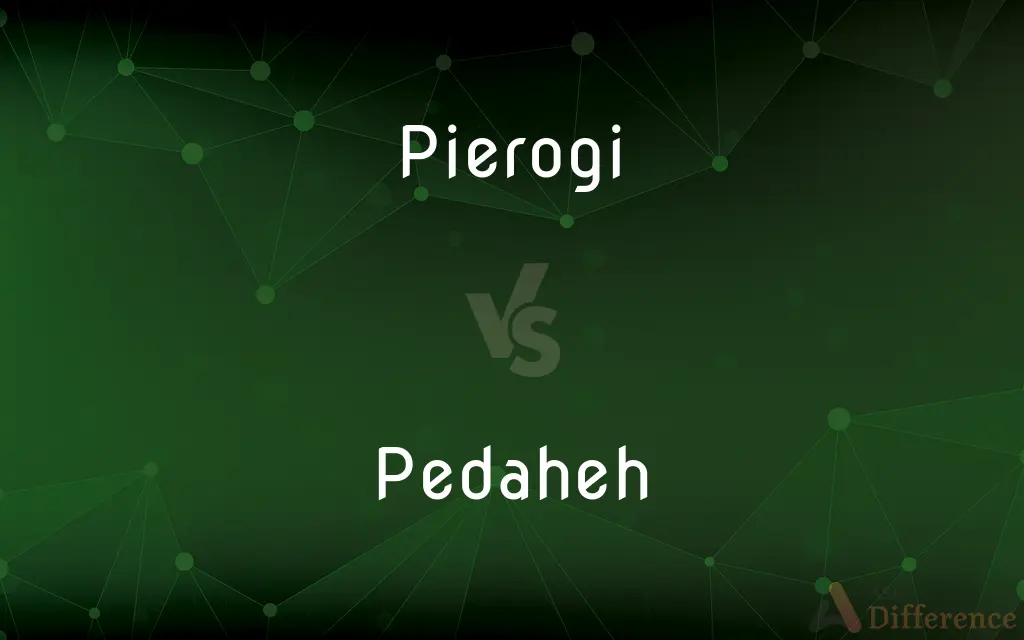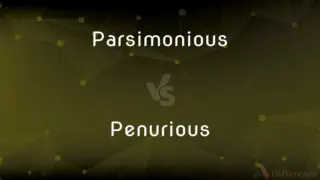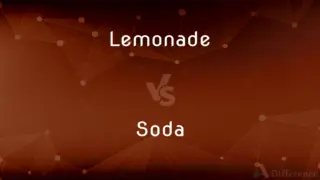Pierogi vs. Pedaheh — What's the Difference?
By Tayyaba Rehman — Updated on October 3, 2023
Pierogi are Eastern European filled dumplings, while pedaheh (often spelled "perogies" in English) is the plural form of the Ukrainian/Russian word for pierogi.

Difference Between Pierogi and Pedaheh
Table of Contents
ADVERTISEMENT
Key Differences
Pierogi and pedaheh both refer to a type of filled dumpling that is popular in Eastern European cuisines. Pierogi is the Polish term, and it can be filled with a variety of ingredients, from savory to sweet, such as meat, mushrooms, or berries. Pedaheh, on the other hand, is often associated with the Ukrainian or Russian form of these dumplings and, while similarly varied in fillings, might be seen as the plural form of the word when transliterated to English.
When discussing the origins of pierogi, they are often traced back to Poland and are considered a national dish. They have been consumed for centuries, with various regional variations existing across the country. Pedaheh, meanwhile, brings to mind the traditions of Ukraine or Russia, emphasizing the ubiquity of these dumplings across various Slavic countries.
Pierogi is generally the term you'd encounter in Poland and among Polish communities abroad. They can be boiled, fried, or baked and are often served with toppings like sautéed onions or sour cream. Pedaheh, while essentially being the same dish, highlights the linguistic variations across different Slavic nations and regions.
One interesting point of divergence is the associated traditions. In Poland, pierogi are especially popular during holidays such as Christmas Eve. Meanwhile, pedaheh is a staple in Ukrainian meals and can be especially associated with celebrations and family gatherings.
Lastly, in terms of global recognition, pierogi might have a slight edge, especially in Western countries, due to the Polish diaspora's influence. Pedaheh, while not as globally recognized under this specific term, emphasizes the broad cultural reach of this delicious dish across Eastern Europe.
ADVERTISEMENT
Comparison Chart
Origin
Poland
Ukraine/Russia
Linguistic Basis
Polish term for the dumplings
Plural form in Ukrainian/Russian
Typical Fillings
Meat, cheese, mushrooms, fruits
Similar fillings but may vary regionally
Associated Traditions
Popular during Polish holidays like Christmas Eve
Staple in Ukrainian meals and gatherings
Global Recognition
Widely recognized due to Polish diaspora
Less recognized by this specific term
Compare with Definitions
Pierogi
Eastern European filled dumplings.
I'm craving some cheese and potato pierogi for dinner.
Pedaheh
Eastern European culinary tradition.
Making pedaheh is a cherished family tradition.
Pierogi
Polish culinary delight.
The restaurant offers an array of traditional pierogi on their menu.
Pedaheh
Often served with sour cream or butter.
These pedaheh taste perfect with a dollop of sour cream.
Pierogi
Boiled, fried, or baked dough parcels.
Golden fried pierogi are my favorite.
Pedaheh
Ukrainian or Russian variant of filled dumplings.
At the festival, there was a stall selling homemade pedaheh.
Pierogi
Dish often served with sour cream or onions.
She served the pierogi with a side of caramelized onions.
Pedaheh
Transliterated term for plural form of pierogi in Ukrainian/Russian.
How many pedaheh are left in the pot?
Pierogi
Savory or sweet stuffed pockets.
For dessert, we had sweet blueberry pierogi.
Pedaheh
Slavic dish similar to pierogi.
I can't decide between pierogi or pedaheh for dinner.
Pierogi
Pierogi ( pih-ROH-ghee) are filled dumplings made by wrapping unleavened dough around a savoury or sweet filling and cooking in boiling water. They are often then pan-fried before serving.
Pedaheh
(North America) A type of Ukrainian dumpling, similar to Polish pierogi. Traditionally called pyrohy or varenyky.
Pierogi
A semicircular dumpling with any of various fillings, such as finely chopped meat or vegetables, that is often sautéed after being boiled.
Pierogi
(North America) A square- or crescent-shaped dumpling of unleavened dough, stuffed with sauerkraut, cheese, mashed potatoes, cabbage, onion, meat, or any combination of these, or with a fruit filling.
Common Curiosities
What are pierogi and pedaheh?
Both are filled dumplings from Eastern European culinary traditions.
Is there a difference in fillings between pierogi and pedaheh?
Both can have similar fillings, but regional variations exist.
And pedaheh?
Pedaheh are associated with Ukrainian and Russian cuisines.
How do you typically cook pierogi?
Pierogi can be boiled, fried, or baked.
Are pierogi and pedaheh the same thing?
Essentially, yes, but the term varies based on regional and linguistic differences.
Where did pierogi originate?
Pierogi originated in Poland.
Is it common to serve pierogi with a topping?
Yes, toppings like sautéed onions or sour cream are popular.
Why might I see "perogies" on a menu instead of "pedaheh"?
"Perogies" is a common English transliteration of the term.
Can I find vegetarian pierogi and pedaheh?
Absolutely, many fillings like cheese, mushrooms, or fruits are vegetarian.
What about pedaheh?
Pedaheh are typically boiled or fried.
Why are pierogi so popular in Poland?
They have a long history in Polish cuisine and are considered a national dish.
Do any traditions surround the serving of pedaheh?
Pedaheh is a staple in Ukrainian meals and can be associated with family gatherings.
Which is more globally recognized, pierogi or pedaheh?
Pierogi might have a slight global edge, especially in Western countries.
Are there sweet versions of pierogi?
Yes, fillings like fruits or sweet cheese can be used.
Are pedaheh served differently in Russia compared to Ukraine?
The basic concept remains the same, but regional variations in fillings or preparation methods might exist.
Share Your Discovery

Previous Comparison
Parsimonious vs. Penurious
Next Comparison
Lemonade vs. SodaAuthor Spotlight
Written by
Tayyaba RehmanTayyaba Rehman is a distinguished writer, currently serving as a primary contributor to askdifference.com. As a researcher in semantics and etymology, Tayyaba's passion for the complexity of languages and their distinctions has found a perfect home on the platform. Tayyaba delves into the intricacies of language, distinguishing between commonly confused words and phrases, thereby providing clarity for readers worldwide.















































